
Over one hundred individual designs of ships (also known as starships) exist in the Star Citizen universe. Some ship designs are variants of a base design, and are said to be in a series.
These ships are used by players and NPCs to explore the universe; conducting trade, fighting over cargo, or performing many other activities. Innumerable combinations of ship components, customization items, and other personal touches allows each ship owner to purchase and build their own personalized starship. Some ships have multiple variants to specialize a ship for a particular role. For example, the Aurora CL has a larger cargo bay than other Auroras for more profitable trading excursions.
All ships are designed to have interchangeable components to suit a pilot's needs, but it is not necessary to change these components to get an effective spacecraft. It is straightforward to purchase a F7C Hornet from Anvil Aerospace with stock equipment and insurance to start bounty hunting criminals immediately. However, if desired, ship owners can spend time and credits to upgrade the shields, replace the weapons, and generally modify the component setup to suit their playstyle. With their customized ship, pilots can engage in any of the available careers either solo or as part of a player-run organization. Many player-run organizations also host skirmishes with other organizations to provide additional reasons to obtain and use combat ships.
Purchasing ships
CIG offers pledge ships for cash in order to help fund the development of Star Citizen. The funding generated by such sales is what allows them to include deeper features in the Star Citizen world. Beyond the affordable starter ships, they will not be required to play the game. Not all ships are available for purchase at all times. It has been said that all ships will be available in-game after launch (although certain ships will be rarer than others and may not be purchasable from in-game dealerships), and many ships are already available for purchase or rental using in-game currency.
Pledge ships can be bought as standalone purchases, as ship upgrades, or with game packages. The first option results in a ship being added to an existing RSI account, but it does not give access to Star Citizen (this makes it most useful for existing backers). The second option replaces a ship that is currently on an account with a more expensive ship while charging only the difference in value between the two ships. The third option includes access to Star Citizen with the ship purchase.
To purchase ships for real currency, see: Pledge Store
Renting ships
Players may rent some ships for in-game currency, with a rental period of either 1, 3, 7, or 30 days.
Production state
Star Citizen is in open development and considered to be in an Alpha state. The ships exist in various levels of readiness:
- Rumored - Not officially acknowledged but has shown up in behind the scenes images or other places.
- Announced - Publicly acknowledged by CIG, but no other work has been done.
- Unknown - Current state hasn't been clarified.
- In Concept - Artists and designers determine the concept look, 3D renders, and functional design for a ship.[1]
- Inactive Production - Production has been shelved temporarily.
- Long Term Production - Development work is planned and has been added to the roadmap.
- Active Production - Development, designers, and QA work from start to finish on the ship to turn its concept into something that works in-game.
- Hangar Ready - Loads in the Hangar Module for display and walk-through. Recent ships have skipped this stage and been released to players as Flight Ready.
- Flight Ready - Can fly in Arena Commander or the PU/PTU with operations including physics, interactions, and most systems. Systems that rely on unimplemented game mechanics (such as science or news broadcasting) are omitted from the ship until their corresponding game mechanics are implemented.
Components
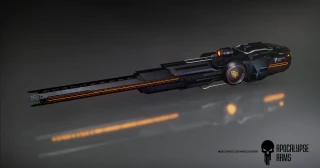
Beyond just the hull, the components are all the devices, equipment, and tools that make up the "working" parts of a ship. From weapons to thrusters, each component has different characteristics that differentiate it from other components in that class. For example, one shield generator may provide an improved recharge rate in exchange for greater power consumption. Equipment and components can be procured from various stores and shops located throughout the universe such as Hardpoint Guys; supplying weapons from Apocalypse Arms or shield generators from Seal Corporation. These components are then attached to your ship and integrated into the power and CPU systems and activated. Beyond simply purchasing and attaching new equipment, pilots may fine-tune, overclock, and test modifications to the components at the risk of damage or destruction.[2]
Components operate on a "Size" system: Size 2 components will only fit and operate properly in Size 2 hardpoints. The only exception is weapons, which work on a more complicated sizing system allowing weapons to be twin-linked, gimbaled, or manned with a compensating size increase, such as a Size 3 weapon that is twin-linked and gimbaled would require a size 5 hardpoint.[3]
Insurance
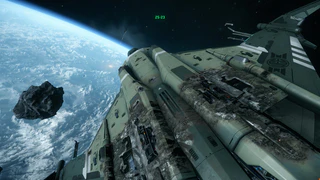
Insurance policies are taken out by pilots for their ships, cargo, and modifications. Basic hull insurance will insure a pilot against the loss of the hull and the stock weapons that it came attached with. A regular fee must be paid to maintain this policy and operates as a reasonable running cost.
Additional insurance policies may be taken out based on risk. The riskier systems that you are taking your ship or cargo through, the higher the premiums will be.
Lifetime Insurance (LTI) is present for any ships:
- purchased before November 26, 2013 by original and veteran backers,[4]
- purchased during their concept sales before April 2018,
- purchased with new money ("warbond") during their concept sales,
- purchased during the Anniversary Sale in 2013,[5]
- that cost $1000 or more,
- that are in a package that costs $1000 or more,
- that are in some other specific packages (such as those available to Concierge backers).
LTI policies never expire and require no running fee, but only cover the base hull and stock weapons. LTI does not exist for modifications or cargo.[6] Insurance claims may be denied in cases of proven fraud.[4]
Cargo
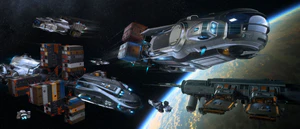
Almost every ship in Star Citizen can carry some amount of cargo: goods, trade resources, weapons, and other materials for transport. Cargo is often purchased for a certain price and sold in a different location for a higher price, earning a profit.
Various boxes and storage containers are used of different sizes and types to allow for the transport of different materials, like perishable goods or livestock. "Stealth" cargo pods also exist for illicit smuggling.
Characters can interact with cargo using their own hands, forklifts, and grav controls to load or offload it from their ships.
Sizes
The Size value is a simplified overview of both the scale of a ship's physicality, and the scope of its player investment. While these values are not absolutes i.e. some Capital ships may be smaller, some Medium ships may be larger, it is intended only to be a starting point in your understanding of a particular ship's place in the Star Citizen universe, and not the final word on what it can and cannot do.[7]
Vehicle
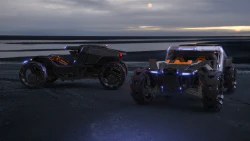
Can only be operated on ground, the range spans from simple personal transport vehicles like the Greycat PTV, through exploration rovers like the Lynx and Ursa to much larger vehicles. Can often be crewed by a single player or a small group.[7]
Snub

A ship that is completely dependent on another ship to work over a wide area. Sometimes referred to as a parasite craft. Will work in space and atmosphere with generally only a single pilot. Often has no Quantum Drive or fuel intakes which limit its range without the parent ship. An example of this is the Dragonfly.[7]
Small

Generally up to 25m in length. Ships that operate in space with Quantum capability. Ideal for solo operators but not exclusively single-seaters. Appropriate for the vast majority of landing pads on stations throughout the verse.[7]
Medium

Most commonly 25-50m in length. Can be operated independently, but will flourish most effectively with additional crew. Often contains living accommodations for the crew to support extended missions or some form of cargo area. Designed to be played with a small group of friends well.[7]
Large

Frequently found in the 50-150m length range, these ships can be operated with a skeleton crew, but really require an experienced medium to large crew working together as a unit throughout the mission to achieve their goals. Maintenance and repair costs often become a significant factor in this size bracket.[7]
Capital

Huge ships that are often (but not exclusively) over 150m in length and require a significant investment in time or crew to maintain let alone run. The crew needs to be skilled in many areas to effectively operate these colossal ships and often need a small fleet of supporting ships to keep them in the best condition or out of harms way. While these ships are not designed for the casual, individual player, they will offer a unique gameplay experience to the dedicated crew who put in the time and resources.[7]
Hangar
The hangar has vehicle sizes that are used to determine at which points vehicles can be placed. As of version 3.12.0, ground vehicles can be spawned at vehicle spawn pads located on planet surfaces. Later versions of the game will allow vehicle spawning to be inside your ship.
Jump points
There are small, medium and large jump points. Some jump points require players to jump to multiple jump points before arriving at their final destination. This will have some relationship to the size of the ships that can pass through them but final determinations on how have not been yet made.
Roles
Most ships and ship variants in the universe are designed and built for a particular purpose, or role, in mind; from the small eleven-meter M50 Interceptor racing ship to the massive one-kilometer UEE Bengal Carrier purpose-built for the military.
Starter
Starter ships are the inexpensive and versatile ships used by fledgling Citizens to explore the universe for the first time. Often single-seat and with a small cross-section, these may be the most common type of ships piloted by Citizens in the universe.
Examples
• Aurora ES • Mustang Alpha • Avenger Titan • Reliant Kore • 100i • 300i
Exploration
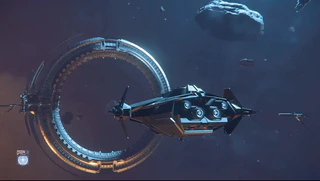
Exploration craft boast powerful sensor suites, larger fuel tanks, and other components to explore frontiers and make grand discoveries. These ships, manned by brave explorers, will delve into unexplored and dangerous jump points just for the chance to discover a new system.
Examples
• 315p • Freelancer DUR • Terrapin • Constellation Aquila • 400i • 600i • Carrack • Corsair
Cargo
Every settlement, station, and ship needs supplies and goods to function; whether the demand is for essential jump fuel or luxurious leather couches. These ships are owned by traders and merchants seeking to deliver these goods for the highest profit, utilizing expanded cargo holds and improved engines to haul as much cargo as possible.
Examples
• Hull (series) • MPUV Cargo • R.A.F.T. • Freelancer MAX • Constellation Taurus • Caterpillar • C2 Hercules
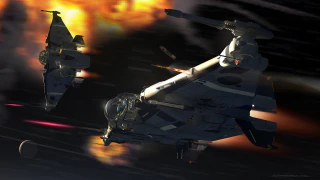
Combat
Combat ships are purpose-built and designed to interdict, outmaneuver, and disable or destroy targeted ships. Bristling with weapons and boasting improved power plants, combat ships have small or non-existent cargo holds and other accessories for maximum combat efficiency. These ships are further broken down into different combat roles.
Fighters
Fighters are combat ships designed for one or two persons; often with forward-facing weapons and focused on taking down other ships of similar size. These fighters can be found all over the universe, whether for bounty hunters or as part of the front line of a capital ship battle.
Examples
• Gladius • Arrow • F7C Hornet • Sabre • Vanguard Warden • Aurora LN • Mustang Delta • 325a • Buccaneer • Reliant Tana • Cutlass Black • P52 Merlin • F8 Lightning • Hurricane
Bombers
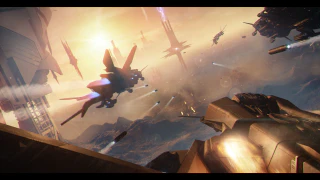
Bombers carry a large payload of torpedoes and other heavy ordnance for tactical strikes against larger targets. Bombers often have fewer anti-fighter weaponry and require a fighter escort to reach the target before being intercepted
Examples
• Vanguard Harbinger • Gladiator • Eclipse • Retaliator • A2 Hercules
Combat utility ships
Combat utility ships are small ships with support equipment, radar, non-lethal weapons, or other specialized equipment. They take on a role beyond simply destroying enemy targets; usually used to support squadrons or fleets with their abilities.
Examples
• Cutlass Blue • F7C-R Hornet Tracker • Avenger Stalker • Avenger Warlock • Vanguard Sentinel
Corvettes

Corvettes are large ships that are nearly as capable as capital ships. They require crew contingents greater than fighters but not as large as a full capital ship. These ships serve as support ships to capitals in large fleets or as flagships of small fleets or militias. They are generally designed for the UEE Navy, with many models having "civilian" versions for sale to the general public.
Examples
• Hammerhead • Nautilus • Perseus
Capital ships
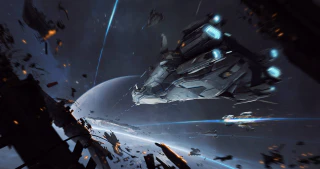
Capital ships are larger, heavier, and carry more people, or crew, than fighters. As with fighters, crewed ships may either be general combat ships or focus on a specific role. Many of these heavier combat ships are part of the UEE Navy and are not available to Citizens
Examples
• Polaris Corvette • Idris Frigate • Javelin Destroyer • Pegasus Escort Carrier • Bengal Carrier • Kraken
Mining
Mining ships work to extract raw materials from asteroids in space and rocks on planetary surfaces. These ships are usually not well armed or armored as their design is full focused on their main goal.
Examples
• ROC • Prospector • MOLE • Orion
Salvage
These ships aim at recovering materials from space junk and derelict ships. They work by pulverizing pieces of ships into small pieces that can be sorted and melted down for recycling.
Examples
Racing
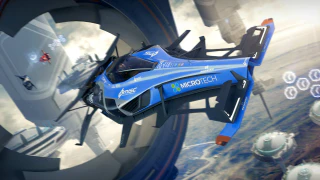
Packing oversized engines and power plants at the expense of every other component, racing ships are unparalleled in their speed and maneuverability. Often lightly armed and free of any cargo hold, these sleek ships can fly at breathtaking speeds as they cruise around a race course; racers dreaming of winning the Murray Cup.
Examples
• M50 Interceptor • Mustang Gamma • Mustang Omega • 350r • Razor
Specialized
With many different roles to fulfill in the universe, these ships often fall into a class of their own; filling a niche need without significant competition. Specialized roles include passenger transportation or scientific research, though the customization of other ships may allow them to fulfill this role to a lesser degree.
Examples
• MPUV Personnel • Genesis Starliner • Reliant Mako • Reliant Sen • Crucible • Herald • Constellation Phoenix • Endeavor • 890 Jump • Mercury Star Runner • Expanse
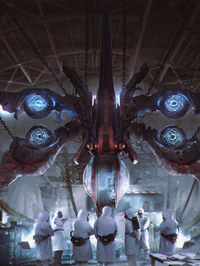
Alien ships
Many alien ships also exist in the universe, most normally not flyable by humans without serious modification. Replica craft are included in the above tables where designed and refitted by human manufacturers for use by Citizens.
Examples
• Blade • Glaive • Scythe • Defender • Khartu-al • Talon • Prowler • Railen • Merchantman • Void • Harvester • Driller • Kingship • Qhire Khartu
Manufacturers
Ship manufacturers design and build ships for military and civilian use, spending decades and billions of credits on research and development.
| Ship Manufacturers | ||
|---|---|---|
| Aegis Dynamics | Growing to prominence in the First Tevarin War, Aegis craft became a symbol of the oppressive Messer regime before shifting into civilian craft. | |
| Anvil Aerospace | A Terra based ship manufacturer with a strong focus on military craft. | |
| AopoA | Xi'an ship manufacturer, also produces the Khartu-al for sale in the UEE. | |
| ARGO Astronautics | ARGO focuses on small utility vehicles such as the MPUV Cargo for intrasystem freight. | |
| Banu | Individual Banu manufacturers which manufactures Banu ships such as the Merchantman. | |
| Consolidated Outland | Produces the affordable but high-quality Mustang series of ships. | |
| Crusader Industries | Crusader designs the Genesis Starliner along with other commercial transports and military thrusters. | |
| Drake Interplanetary | Drake offers ships for militia and the less morally inclined. Ships such as the Cutlass are often found in pirate gangs and outposts. | |
| Esperia Inc. | Produces alien ship replicas for private collectors and the military for training purposes. | |
| Gatac Manufacture | Produces Xi'an commercial and industrial space craft for interspecies utilization. | |
| Kruger Intergalactic | Primarily a weapons manufacturer, Kruger leveraged a deal with RSI to produce snub fighters for the Constellation. | |
| Musashi Industrial and Starflight Concern | Musashi Industrial and Starflight Concern produces reliable industrial ships that can be found in the hands of traders, explorers, and miners. | |
| Origin Jumpworks GmbH | Origin Jumpworks focuses on high-end luxury ships such as the 300i with many variants to specialize the model. | |
| Roberts Space Industries | The original creators of the quantum drive, RSI's large lineup of ships are versatile and reliable. | |
See also
References
- ↑ RSI Knowledge Base - Loaner Matrix. Knowledge Base. Retrieved 2021-08-08
- ↑ Comm-Link detailing the hardpoints and ship components. Transmission - Comm-Link
- ↑
RSI forum DevPost detailing the updated weapon sizing system
- ↑ Jump up to: 4.0 4.1 Lifetime Insurance Clarification. Transmission - Comm-Link
- ↑ Anniversary Sale Details. Transmission - Comm-Link
- ↑ RSI Insurance FAQ and Update. Transmission - Comm-Link
- ↑ Jump up to: 7.0 7.1 7.2 7.3 7.4 7.5 7.6 The Shipyard: Ship Technical Information. Engineering - Comm-Link